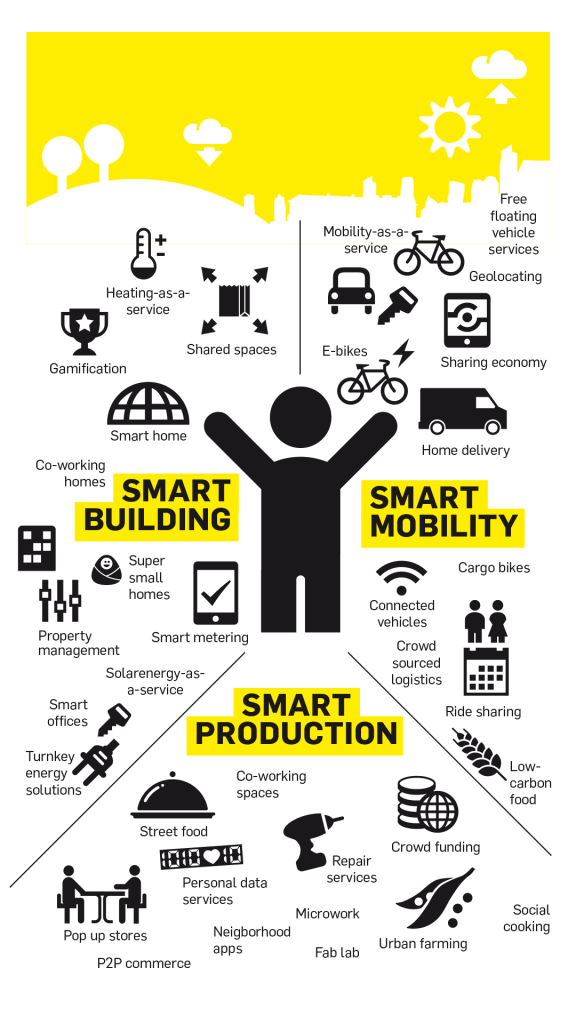For the past half-century, the central functions of our cities – housing, mobility, work and commerce – have remained more or less unchanged. Technical improvements have been incremental, business models have not diversified. Market structures are in many cases still very similar to how they were fifty years ago. It…
For the past half-century, the central functions of our cities – housing, mobility, work and commerce – have remained more or less unchanged. Technical improvements have been incremental, business models have not diversified. Market structures are in many cases still very similar to how they were fifty years ago. It appears, however, that we are about to witness remarkable changes in the way we live, move, work and shop in cities.
Did you know sensors will soon contact everything that surrounds us to the Internet? These sensors can be located, controlled and shared through digital service platforms. By 2020 around 50 billion devices will be connected to the Internet. There will be several Smartups turning resources, that these digital advances are providing, into new types of smart services. New emerging practices will help make better use of existing stocks of goods and spaces in urban environments, as the internet of things will enable as-a-service models. It follows that any such things that previously had to be owned or at least rented for substantial periods, can now be traded and used as-a-service.
Changes in living and mobility
Buildings, homes, offices and all their devices will soon be controlled through smart devices. This will help optimise their energy use and enable smart sharing of homes, offices and other types of spaces.
Mobility options used to be confined to either driving a private car, bike or motorbike, using public transit or walking. The boundaries between them are beginning to blur. Journey planner applications have already made it easier to combine different modalities. Services based on sharing rides, cars, deliveries, bikes, and other vehicles in conjunction with digital service platforms have become the norm in urban environments around the world. Mobility is becoming a service, and not owning a vehicle can offer flexibility not achieved otherwise.
Patterns of work are evolving
Spaces of production and work change because our patterns of work are evolving. Many new coworking places have been created recently. M.O.W (Mothership of Work) coworking space just opened their doors for small companies and freelancers in Helsinki. Oakland Impact Hub is an impact concentrated entrepreneurial community and coworking space to create solutions for a world that works for all. Hoffice-consept, where people are working together at someone’s home, started from Stockholm. Now the service is used worldwide. All these services have emerged recently and tells that the change of work is starting to require changes from physical spaces and cities.
Many types of tasks can now be distributed to several locations and to several people because of fast digital communication. There is less of a need for people to gather into an office to work together, which opens people to new types of working environments, co working spaces and shared spaces. In addition, there will be more temporary shops, restaurants and other types of pop-up businesses in shop spaces, offices, containers and tents. Next we are likely to witness new types of manufacturing spaces in the form of fab labs and other makerspaces.
Applications shaping behaviour
Behaviour will be shaped by different types of behavioural applications that encourage and assist us to live smarter and healthier. Gamified tools help us attain goals, whether related to work or leisure time, in a playful manner. We can already see a new layer of social behavior and collaboration taking place in urban spaces and neighbourhoods, created by digital social networks initiated by social media tools. These solutions will provide new functions and purposes for urban spaces.
Digital urban services will change the way we perceive, use and shape the urban space around us
While buildings, roads, parks and plazas may look the same as they do today, how they are used and perceived will change. What used to be a photo shop will be a temporary test space for new services. What used to be a garage will turn into a repair shop or a fab lab. What used to be plaza or a parking lot will be filed street food stalls. What used to be a private home can be a temporary office for a group of freelancers during daytime. What used to be a private vehicle can be a taxi or a rental car. And the list continues. All in all, the built structures of our cities in 2040 will appear largely similar to how they look today. However, digital urban services will change the way we perceive, use and shape the urban space around us.
This is a chapter from Nordic Cities Beyond Digital Disruption, a report by Demos Helsinki led project Smart Retro. The chapters are part of a series of blog posts featuring excerpts from the report and commentary interviews by world leading experts in urban development.
Praise for Nordic Cities Beyond Digital Disruption:
The built environment has great inertia against change. This is an obstacle against necessary change – i.e. urban sustainable development. One Window-of-Opportunity-reducing inertia is the smart application of ICT. This gives better control of e.g. energy and ventilation systems. ICT also enables new forms of information exchange and of persuasion on sustainability issues – between residents and with real estate owners, energy pro- viders and other local actors.
– Örjan Svane, Professor Emeritus in Urban Sustainable Development in KTH


